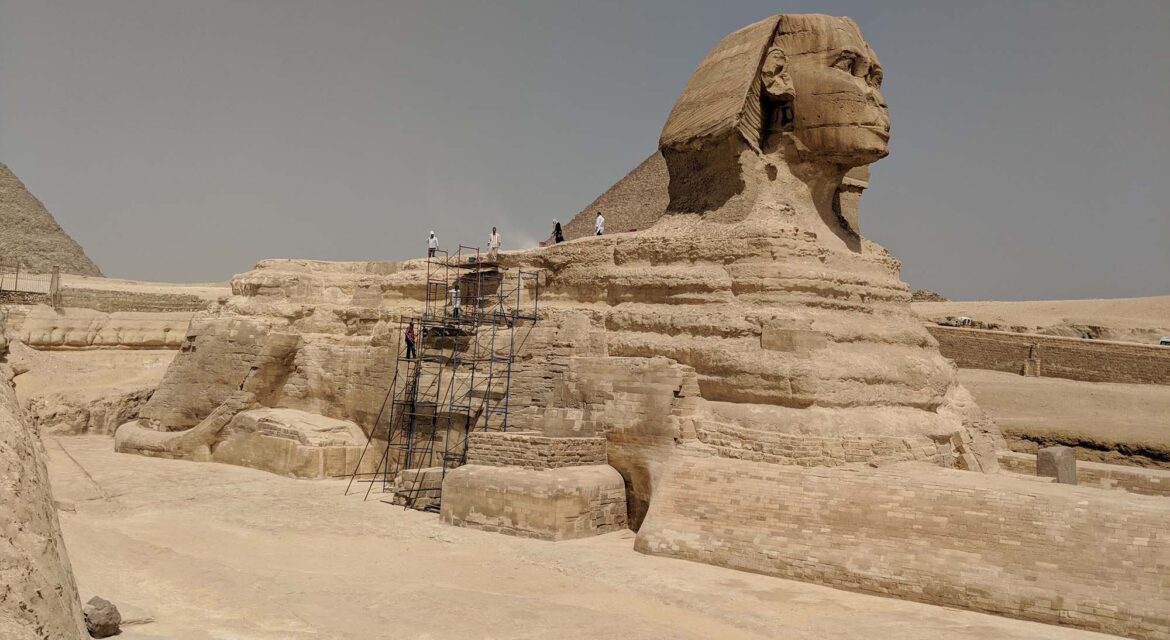 Known as the largest monolith statue in the world, the Great Sphinx of Giza is also one of the oldest sculptures in the world. Residing just outside of Cairo in Egypt, the notoriety of the piece has enabled it to attract audiences from all over the world and become a symbol of Egypt. The significance of doing so has impacted entire cultures and entire economics across the ages.
Known as the largest monolith statue in the world, the Great Sphinx of Giza is also one of the oldest sculptures in the world. Residing just outside of Cairo in Egypt, the notoriety of the piece has enabled it to attract audiences from all over the world and become a symbol of Egypt. The significance of doing so has impacted entire cultures and entire economics across the ages.

Carved Out of the Bedrock of the Giza Plateau

The Great Spinx of Giza resides in the Giza pyramid complex that also contains the Great Pyramids of Egypt, all of which are associated with the Old Kingdom of Ancient Egypt from the 25th century BC. The limestone sculpture is 240 feet long and 66 feet tall and features the body of a lion and the head of a human.
The purpose and history of the piece have been debated over the centuries. While many alternative theories about the origin of the Great Sphinx exist, most Egyptologists believe the Great Sphinx was carved around 2500 BC to serve as a “guardian” for the Second Pyramid at Giza, built by the pharaoh Khafre. However, no contemporary inscriptions connect the Great Sphinx to the pyramid.
The Giza pyramid complex was eventually abandoned which allowed sand to bury the Great Sphinx up to its shoulders. This compelled many excavation efforts over the centuries, the most famous of which was performed by Thutmose IV in 1400 BC, who installed the Dream Stele as part of the endeavor. Modern attempts to unbury the Sphinx began in the 1880s, but it wasn’t until the late 1930s that the Great Sphinx was freed from the sand for good.
Legends around how the Great Sphinx lost its nose, who it actually depicts and what it means to ensure the piece is both restored and protected have piqued the interest of audiences of all types. The incredible size and notoriety of the piece have allowed it to become an icon of Egypt that attracts attention and interest from across the world.

Impacting the Culture of Egypt in the Present and Future
 One of the most famous and recognizable monuments in the world, the Great Sphinx has been utilized as icon of Egypt for centuries. That impact can be seen by how it is utilized in everything from maps to currency to products, all of which have helped to shape the economy and culture of Egypt.
One of the most famous and recognizable monuments in the world, the Great Sphinx has been utilized as icon of Egypt for centuries. That impact can be seen by how it is utilized in everything from maps to currency to products, all of which have helped to shape the economy and culture of Egypt.
The Great Sphinx is also a major feature of the Sound and Light Show Egypt, which a takes visitors on a journey back to thousands of years ago to bring the Egyptian legacy to life. This history is re-told by the Great Sphinx, utilizing the monument in an incredibly profound manner to create a direct economic impact.
The distinctive look of the Great Sphinx have allowed it to become one of the most recognizable monuments in the world, a notoriety which is further bolstered by its incredible size and legacy. That legacy is unique to Egypt and the Sphinx, but it also illustrates what’s possible with the creation of such monumental sculptures.
The Legacy of the Great Sphinx
 The legacy that the Great Sphinx has come to represent is ultimately the result of an endeavor to carve a sculpture out of a single mass of limestone that was exposed when workers were digging into the Giza plateau. While the 4,500-year-old limestone sculpture is a monument of a scale and scope that few other pieces could ever hope to copy or recreate, the impact it has created for audiences across the eras showcases how such incredible results can come achieved from very humble origins.
The legacy that the Great Sphinx has come to represent is ultimately the result of an endeavor to carve a sculpture out of a single mass of limestone that was exposed when workers were digging into the Giza plateau. While the 4,500-year-old limestone sculpture is a monument of a scale and scope that few other pieces could ever hope to copy or recreate, the impact it has created for audiences across the eras showcases how such incredible results can come achieved from very humble origins.


